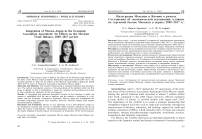Integration of Mexico-Japan in the economic association agreement: its effects on the Mexican trade balance, 2005-2017 period
Автор: Vargas-hernandez Jose G., Gutierrez Anel G. M.
Журнал: Регионология @regionsar
Рубрика: Мировая экономика
Статья в выпуске: 2 (103) т.26, 2018 года.
Бесплатный доступ
Introduction. This research seeks to analyze the effects of the Mexican trade balance on the basis of the Mexico-Japan Economic Partnership Agreement period 2005-2017. The research question is: what are the effects of the Mexican trade balance during the period 2005-2017 in terms of Economic Association Agreement Mexico-Japan? Materials and Methods. The research method used is empirical-analytical and documentary. The current investigation consists of the antecedents of the problem which are first given to delimit it, then a justification is made, the variables and hypotheses are raised, to later establish the objectives of the investigation. Results. A conceptual and empirical theoretical revision of the literature is made; the context is established with the unit of analysis and the method is developed. it is obtained, that the Economic Association Agreement Mexico-Japan has strengthened the economic relationship between both countries. However, Mexican exports need support and development programs. Discussion and Conclusion. Mexico is very important to be a self-sufficient country in the production of goods and services to establish stable economic indicators that do not affect the country's trade balance. The practical importance of the study assumes the use of the results obtained in future projects of economists of researchers of the world economy.
Economic association agreement mexico-japan, mexican trade balance, foreign direct investment
Короткий адрес: https://sciup.org/147221884
IDR: 147221884 | УДК: 339.924(72+520) | DOI: 10.15507/2413-1407.103.026.201802.202-229
Текст научной статьи Integration of Mexico-Japan in the economic association agreement: its effects on the Mexican trade balance, 2005-2017 period
ISSN 2587-8549 (Print) ISSN 2413-1407 (Online)
Introduction. April 1, 2017 marked the 12th anniversary of the entry into force of the Economic Association Agreement (EPA) Mexico-Japan. During this period, bilateral trade increased to almost 7 million dollars until 2016, compared to the 2005 figure; however, Mexico maintains a trade deficit of almost 13 million dollars with Japan until 2016. The importance of the AAEMJ is to create a strategic partnership that strengthens bilateral activities such as trade and investment, through the improvement of business, education, job training, support for small and medium enterprises (SMEs); which includes rules of origin and customs procedures, sanitary and phytosanitary regulations, investment, services, competition and bilateral cooperation.
For Mexico, the AAEMJ represents an important opportunity to boost exports to the Japanese market and attract investment to increase produc-
^^ Том 26, № 2, 2018 РЕГИОНОЛОГИЯ tion, employment, and competitiveness. In addition to encouragement by Japan to SMEs through cooperative support. For Japan, the condition of the agreement is to take advantage of the country as a platform to export to the United States, Europe and South America.
The current investigation consists of the antecedents of the problem which are first given to delimit it, then a justification is made, the variables and hypotheses are raised, to later establish the objectives of the investigation; later, a conceptual and empirical theoretical revision of the literature is made; the context is established with the unit of analysis and the method is developed. Finally, the results are presented with their conclusions.
The Mexico-Japan Economic Association Agreement (AAEMJ) was signed on September 17, 2004 and entered into force as of April 1, 2005. This Agreement links us to the second largest economy in the world, and contributes to increase the production, employment and competitiveness1. From the external debt of 1982, the economic policy of Mexico adopted an export-oriented industrialization model, seeking the development of its economy through the capture of foreign direct investment (FDI) from multinational companies and the export of industrial products. “Mexico is open to receiving FDI through the elimination of trade barriers, the establishment of a maquiladora regime, etc.” [1, p. 49]. As effects of Japanese Foreign Direct Investment (FDI) placed in Mexico has achieved high percentages, becoming Japan as the second destination for Mexico of exports and the first investment partner in Mexico.
Pro Mexico mentions that as a result of the signing of the AAEMJ, a considerable amount of trade has been obtained between both countries, having grown by 73,4 %, from 12,758 million dollars in 2004, to the aforementioned 22,129 million dollars in 2015. In recent years, Japan has become the second destination for Mexico of agricultural and food exports. Japanese foreign direct investment has had a great impact in Mexican territory, mainly for Japanese companies with an investment of 20,000 million dollars. In 2015, foreign direct investment in Mexico was $ 1,329 million, which made Japan the first Asian investment partner and third worldwide with 4,7 % of the total2.
Japanese companies promote the creation of employment sources in Mexico, in addition to the technological transfer that contributes to im- prove the quality of life of the communities where they are established. However, the result of the trade balance is deficit within the Mexican economy, due to the growth of imports that come from Japan, for the establishment of industrial plants subsidiary of Japanese companies. Ya. Tokoro points out that however, for ten years the deficit of the bilateral trade balance is four times more favorable to Japan. Exports to Japan have not grown in recent years, which shows that there has only been one import opening that only benefits Japanese trade [1, p. 54].
The strategic sectors in Mexico show a great disparity to Japan, since they show the great Japanese development and the weak Mexican economy. Mexico is in charge of providing raw materials for Japan, mainly food and agriculture; Japanese electrical / electronic products participate in an important way in the Mexican market.
Delimitation of the problem. The present investigation delimits for its application of study the international context Mexico-Japan in the international relation that occurs through the Agreement of Economic Association with the objective of analyzing and identifying its effects in the Mexican trade balance. The country of Mexico, as a result of the elimination of trade barriers to the Japanese country, has resulted in an increase in Japanese EDI, causing an increase in imports in Mexico, maintaining rates with ups and downs and a decreasing trend in international trade.
Mexico maintains a deficit trade balance against Japan at an average of close to 13,000 million dollars per year until 2016, due to import requirements in the assembly of manufacturing industries, as well as imports of automobiles. It should be noted that domestic exporters are not taking full advantage of the agreement. Japan granted Mexico annual quotas of products that can be exported without paying a tariff and that are not being used 100 %, as would be the case of leather, footwear and honey products among others [2, p. 117]. The lack of development in infrastructure, transportation costs, the inaccuracy of information to carry out exports, such as the lack of investment in maritime ports, leads to operational deficiencies that become an export obstacle for Mexican SMEs.
According to the previous approaches, the research tries to answer the following questions:
-
a) What behavior has the Mexican trade balance had during the period 2005-2017 according to the Agreement of the Mexico-Japan Economic Association?
-
b) How is Mexico’s international competitiveness compared to Japan in the period 2005-2017, depending on the business opportunities, institutional framework and macroeconomics of the country?
-
c) What is the economic growth that Mexico has had during the bilateral relationship with Japan period 2005-2017, according to the business opportunities, institutional framework and macroeconomics of the country?
Justification. Currently, international economic and trade relations between countries play a very important role. An influential factor to carry out free trade is globalization through international treaties or agreements. The AAEMJ opens the possibility of increasing the trade of products and services between both countries in order to complement the advantages and disadvantages of the parties. The bilateral relationship set forth in this agreement shows negative results in macroeconomic terms since 2008.
Variables and hypothesis of work. General hypothesis; The Mexico-Japan Economic Association Agreement does not have a positive influence on the commercial balance.
Specific hypotheses; Business opportunities impact the balance and imbalance of the country. The institutional framework influences the international competitiveness of a country. Macroeconomics in a country determines its economic growth.
In the current investigation correspond the following objectives:
-
- General objective: To analyze the result of the Mexican trade balance during the 2005-2017 period according to the Mexico-Japan Economic Association Agreement;
- Specific objectives: To determine the result of the balance of payments in Mexico period 2005-2017, according to the business opportunities, institutional framework and macroeconomics of the country. To analyze competitiveness in Mexico in the 2005-2017 period, based on business opportunities, institutional framework and the country’s macroeconomics. To identify economic growth in Mexico period 2005-2017,
based on business opportunities, institutional framework and macroeconomics.
To enter the research, it is necessary to expose the basic concepts and main theories of the research variables. In the first place, the concept of the Economic Partnership Agreement Mexico Japan is explained, ending with the commercial balance.
Mexico Japan Economic Association Agreement. The Mexico Japan Association Agreement aims to improve economic relations between Mexico Japan through Japanese investment and the increase of Mexican exports. G. M. Delgado details the Mexico Japan Economic Association Agreement: The Mexico Japan Economic Association Agreement was signed on September 17, 2004, by Prime Minister Junichiro Koizumi and President Vicente Fox, during the state visit made by the ruler Japanese to Mexico. The document was approved in the Mexican Senate on November 18 of the same year, and entered into force on April 1, 2005 [3, p. 277].
The Mexico-Japan Economic Partnership Agreement has as a priority the unblocking of bilateral trade between Mexico and Japan, through the liberalization of economies. G. Garcia defines the Mexico Japan Economic Association Agreement as the Mexico Japan Economic Association Agreement was signed on September 17, 2004 and entered into operation on April 1, 2005. The objective of the EPA is to promote trade liberalization and the investment between Mexico Japan [4, p. 118].
The AAEMJ contemplates legal aspects that determine practices to promote socioeconomic relations between both countries and thus strengthen the diplomacy between both countries. The EPA contemplates the elements of a free trade agreement, as well as various provisions to intensify bilateral cooperation and promote social and economic rapprochement between both countries3. The Economic Association Agreement Mexico Japan entered into force on April 1, 2005. It has as its main objective, to originate the economic and social development between both countries and has elements to intensify bilateral cooperation and promote investment between Mexico and Japan.
Trade balance. Next, some authors of the state of the art who parley different concepts and the functions of the commercial Scale are announced: Robinson delimits that for any country an increase of the trade balance is equivalent to an increase of the investment, which usually leads (given the level of national investment) to an increase in employment.
^^ Том 26, № 2, 2018 РЕГИОНОЛОГИЯ The increase in the trade balance of a country at best does not affect the level of world occupation. The decline in a country’s imports means the decline of exports from other countries, and the balance of the trade balance for the world as a whole is always equal to zero4.
Clearly, Robinson explains that the trade balance can show positive and negative balances depending on bilateral trade. The main cause of the balance, are the investments that are established within a country, based on the growth of investments increase both exports and imports of a country. R. J. Paschoal defines the commercial balance as it generally includes the highest values of the balance of payments. That balance is defined as the difference between exports and merchandise imports. Regarding the value that exceeds that of imports, it is said that there is an active trade balance; in the opposite case, it is said that there is a passive trade balance [5, p. 688].
The trade deficit is a result of the lack of self-sufficiency on the part of a country and little development, lack of productivity, inflation, and little support for companies are factors that lead to low export levels. Therefore, a country that does not produce according to the needs of the society that forms a country before a globalized world. It implies that the country requires buying goods and services abroad, for the benefit of countries with a gross domestic product and a high GDP per capita.
Finally, M. S. Vazquez, R. J. Madrigal mention that in the commercial balance a trade deficit or surplus may occur depending on foreign trade: It measures the differences between exports and imports of a country. There is a deficit when the balance of the trade balance is negative, that is, it is imported more than what is exported and a surplus when the value of exports exceeds imports [7, p. 20]. The trade balance records the number of exports and imports made in a country during a fixed period. Subsequently, it determines the balance of the trade balance by establishing a trade deficit or surplus of a country. The final result of the Trade Balance affects the economic activity of a country.
Review of theories. Subsequently, the main theoretical complements of the variables are presented, which were considered by the classical and neoclassical theories. First, the complementary theories of the variable independent are shown (table 1).
The classic theory of the comparative advantages of D. Ricardo mentions that each country has different economies, which leads to the specialization of products or services, depending on the technological, industrial, labor capabilities, etc. According to the theory of Heckscher and Ohlin, the intensive technologies of each country determine the level of productivity of each country relative to work, where the price of the factors is impacted in the price of the goods, a country exports the goods that it produces according to the technological intensity of the country. The new theory of international trade by P. Krugman mentions that it has two principles that are imperfect competition and intra-industry trade, involve greater technological progress, monopolies, aggressive policies of protectionism, foreign direct investment, etc. They are factors that impact on the competitiveness of countries, for international trade.
The theories that apply in this investigation are three, those of Krugman, D. Ricardo and Heckscher & Ohlin; they determine and describe exactly the aspects established in the AAEMJ. These theories allow the analysis of the characteristics and results achieved in the AAEMJ (table 2).
The following theories were found for the variable (Y). The main theories on the commercial balance are analyzed, authors like D. North (1970) and Krugman and Obstfeld (1953) are mentioned; They explain how the growth or development of a country’s production impacts on the behavior of the commercial balance. Douglas North (1970) states that the regions of today are economies open to globalization, an era that implies trade opening and determines that each country produces goods and services, and then trade with other countries. Krugman and Obstfeld (1953) explain in their standard model of trade, that each country has different capacities to produce, the level of productivity depends on the economic capacity, lack of technology, economic and social development of the country, which limits the capacity production of a country. Therefore, the demand and supply of goods and services determine the balance in trade with other countries. It is important to maintain balanced macroeconomic levels in order to increase or maintain a good international competitiveness that has an impact on the country’s socioeconomic stability.

В 05 =5 05 Ю
О я о а о :-
2 2 а о
Н
ВТ S ч ю
CQ




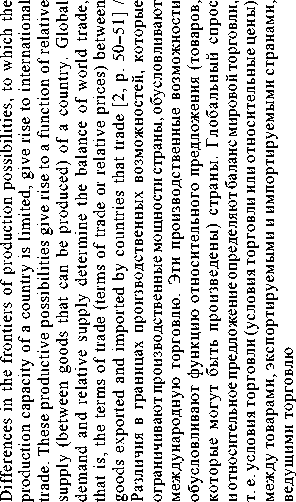
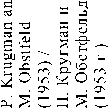
In this research the two theories are applied since they clearly describe how the economic indicators of a country cause effects in the commercial balance, such as GDP, International Trade, open economies, demand, supply, etc.
An empirical review of the literature is presented in Table 3.
Contextual framework: Mexico-Japan association agreement its effects on the Mexican commercial balance period 2005-2017. The Mexico Japan Economic Partnership Agreement is signed by President Vicente Fox Quesada and Prime Minister Junichiro Kouizumi on September 17, 2004 and enters into force on April 21, 2005. According to Sohs & Katada (2007), cited by T. Okabe & R. S. Carrillo, find two reasons: the most important was to grant free access to the Mexican market to Japanese automobile manufacturers, to electronic products and others [2, p. 41]. As a fundamental part of any treaty, important rales and aspects to consider when signing an agreement must be constructed to establish the interests of both countries. Below, the commercial provisions that constitute the AAEMJ are presented.
Commercial provisions of the EPA. According to CONAPO5, it explains the dispositions to markets of goods that the AAEMJ implements within the agro-food and fishing sector, Mexico within this treaty plays a role of main exporter of agro-food products to Japan, (s.p). Japan is the third importer of agro-food products in the world, with annual imports of around 50 billion dollars of agro-food and fishery products. In the agro-food sector, Japan imports around 35 billion dollars, which is almost double the total trade of agro food products among the member countries of NAFTA (Canada, the United States and Mexico)6.
In the negotiations of the EPA, real export opportunities were achieved where Mexico has great potential, through tariff and non-tariff advantages that allows to increase the participation in the Japanese market, with long-term legal certainty that no other country has to Japan. Mexico gained access to the Japanese market in products with great potential in this sector: green coffee, asparagus, fresh broccoli, tomato, cabbage, pumpkins, eggplant, legumes, lemons, mango, avocado, guava, papaya, egg, pectin, wines, tobacco, albumin7.
A preferential access was negotiated with quotas for very sensitive products for Japan and of great interest for the Mexican productive sector. Quotas were obtained for the Mexican productive sector in the following products: pork meat, beef, chicken meat, orange juice, honey, catsup, pasta, tomato puree, sorbitol, orange, dextrins8.
Table 3. Empirical review of the literature4 Таблица 3. Эмпирический обзор литературы

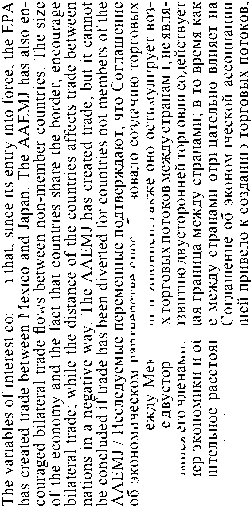
s В ”
я a s я ™ 2
gS £
S 5
Я 5 я = однако неизвестно, были ли переориентированы торговые потоки стран, не являющихся членами Соглашения.
§ я
2 ® я s
§ 3
2^
с я 2
S я

= Я
1) Я я tx
2 s я о
Я у
^i,=
T
Я s
я s 3 я ^ й S 2 o*S у о S о Я я н у g он*



Japan is one of the leading importers of fishery products in the world. Mexico negotiated that all products of interest are included in the Agreement, which represent almost 80 % of Mexican exports of fishery products to Japan. Among the main products that have immediate tariff-free access are fresh and canned yellowfin tuna, shrimp, some crustaceans and mollusks and octopus. For sardines and squid, quotas were negotiated.
According to CONAPO for the automotive sector, of interest to Japan and sensitive to Mexico, the following scheme was negotiated: Japan was granted immediate access for only an amount equivalent to 5 % of the domestic automobile market. Under the current regime for the promotion of the Mexican automotive industry, the equivalent of 3 % of the national market is already free of duty9.
Table 4. List of Japanese products with immediate access to Mexico4
Таблица 4. Список японских товаров, получивших непосредственный доступ на мексиканский рынок
|
Capital goods / Средства производства |
Electrical manufactures / Электрическое оборудование |
Electronic equipment / Электронное оборудование |
|
Hydraulic turbines / Гидравлические турбины |
Air generators / Генераторы воздуха |
Computers / Компьютеры |
|
Certain compressors / Компрессоры определенного типа |
Certain power generators / Электрогенераторы определенного типа |
Printers / Принтеры |
|
Mechanical cranes with or without boom / Механические краны co стрелой или без стрелы |
Sources / power amplifiers / Источники питания и усилители мощности |
Monitors / Мониторы |
|
Forklifts / Вилочные по- |
Illuminated indicators / |
Equipment to interconnect |
|
грузчики |
Световые индикаторы |
networks / Оборудование для соединения сетей |
|
Mechanical shovels / Me- |
Audio and video switch- |
Telephone operator serv- |
|
ханические лопаты |
boards / Аудио- и видеокоммутаторы |
ers / Серверы телефонной связи |
|
Excavators / Экскава- |
Audio conference gen- |
Mini telephones / Мини- |
|
торы |
erators / Генераторы аудиоконференций |
АТС |
Own elaboration / Авторская обработка данных
The promotion of activities in areas such as support industry; small and medium businesses; promotion to trade and investment; These are provisions that allow the strengthening of economic relations between both countries, in terms of bilateral cooperation. Pro Mexico mentions the percentage of tariff liberalization with respect to Japan, and shows great immediate access free of duty: Japan immediately released 91 % and in the medium term 4 % of the tariff currently applied to Mexico for 95 % of the tariff fractions. The remaining 5 % of the tariff fractions consists of sensitive products10. Japan grants immediate tariff-free access to Mexico under quotas: leather footwear and clothing apparel.
Mexico immediately released 44 % of the tariff fractions that currently apply to Japan. Within this 44 % of the tariff fractions are included mainly items that are not produced in Mexico and inputs for domestic industry, such as high-tech products, (s.p). Below is a list of Japanese products that have immediate access to Mexico (table 4).
Some of the characteristics that differentiate Japan from Mexico:
-
- Japan is the second largest economy in the world (GDP per capita 34100 $);
-
- The population has an average age of 43 years and a highly educated workforce;
-
- It is the eighth source of foreign direct investment (FDI) worldwide;
-
- It is one of the countries with the highest savings rates;
-
- Leading producer and exporter of high technology products;
-
- It imports 60 % of its food consumption (3rd importer worldwide);
-
- It is the main market in Asia of Mexican exports.
The characteristics that differentiate Mexico from Japan:
-
- Abundant young and skilled workforce of average age of 27 years;
-
- Economy that needs increasing levels of FDI and domestic investment;
-
- Importer of high technology systems and products;
-
- Producer and exporter of value-added products and maquila resources;
-
- Producer and exporter of agricultural products (table 5).
As a result of the AAEMJ, it is obtained that some agro-food and industrial products in tariff-free preferential access are shown in a table below (table 6).
Research methods. The type of research that is carried out in this study is of an empirical-analytical nature (quantitative) based on the investigation, analysis and verification of numerical data. This research is also documentary, since it focuses on research, interpretation of documents for the presentation of data and information. The data collection is carried out under a period of time, as far as a longitudinal investigation is concerned.
Table 5. Mexico-Japan complementarity11
Таблица 5. Взаимодополняемость Мексики и Японии
Japan / Япония
Third world economy / Третья экономика мира
Population with an average age of 46 years / Средний возраст населения - 46 лет
Highly trained workforce / Высококвалифицированная рабочая сила
Among the developed economies, Japan is the second largest source of foreign direct investment globally / Среди развитых стран Япония является вторым по величине источником прямых иностранных инвестиций в мире
Producer and exporter of high technology products / Производитель и экспортер высокотехнологичной продукции
Importer of goods with medium-high technology such as electronics, household appliances, and the automotive sector / Импортер товаров co средне-высокими технологиями, таких как электроника, бытовая техника и автомобильная продукция
Importer of 60 % of their food consumption (third place in the world) / Импортер 60 % потребляемых продуктов питания (третье место в мире)
Mexico / Мексика
Fifteenth economy in the world / Пятнадцатая экономика в мире
Population with an average age of 27 years / Средний возраст населения - 27 лет
Abundant young and skilled workforce / Богатые ресурсы молодой и квалифицированной рабочей силы
Thirteenth place as a pole of attraction for foreign direct investment worldwide and the third in Latin American / Тринадцатое место в качестве полюса привлечения прямых иностранных инвестиций во всем мире и третье место в Латинской Америке
Importer of high technology products / Импортер высокотехнологичной продукции
Producer and exporter of goods with medium-high technology and agio-food / Производитель и экспортер товаров со средне-высокими технологиями и агро-продовольственной продукции
Need to complement national investment with foreign / Необходимость дополнения национальных инвестиций иностранными
Design of the investigation. The collection of quantitative information is obtained by means of measuring instruments useful for obtaining numerical data, by means of a sequence of time.
Research instruments. The instrument used in this research is the analysis of documents, because the case study that is addressed requires a process of interpretation and analysis of information. An analytical-synthetic process is carried out, because the information is studied, interpreted and synthesized to give rise to a new document that is easier to access and disseminate. For the statistical analysis, the Excel program is used and queries are made in Banxico, the World Bank and Macro Data where numerical data on the behavior of each of the indicators is determined; to then, represent the results by means of graphs and take them to the observation and analysis of the figures.
Table 6. Agro-food and industrial products with preferential tariff-free access 12
Таблица 6. Агропродовольственные и промышленные товары с преференциальным беспошлинным доступом
Agro-food and industrial sectors / Агропро-довольственный и промышленный сектора
Industrial sector / Промышленный сектор
Tariff-free products / Товары, не облагаемые пошлиной:
-
- Meat and leather products / Мясные и кожевенные изделия;
-
- Leather footwear / Кожаная обувь;
-
- Leather article / Изделия из кожи;
-
- Garments and clothing accessories / Одежда и аксессуары;
-
- Sorbitol / Сорбит;
-
- Dextrins / Декстрины;
-
- Citric acid / Лимонная кислота
Products with tariff preference within quota / Товары с тарифной преференцией в пределах квоты:
-
- Beef, pork, chicken and processed / Говядина, свинина, курица, в том числе переработанные;
-
- Juice of concentrated orange and; deconcentrated / Концентрированный и деконцентрированный апельсиновый сок;
-
- Fresh orange / Свежие апельсины;
-
- Agave syrup / Сироп агавы;
-
- Natural honey / Натуральный мед;
-
- Banana / Бананы;
-
- Pasta and tomato puree / Макаронные изделия и томатное пюре;
-
- Tomato sauces / Томатные соусы
Results. Table 7 presents the results based on the documentary analysis on trade and investment, customs procedures and rules of origin and infrastructure: consecutively, the quantitative results of the statistical analysis are shown in graphs, on the number of exports and imports, inflation, infrastructure and Gross Domestic Product.
Analyzing the results, it is determined that the total trade of Mexico has increased 6,974,282 million dollars from 2005-2016 showing a growth of exports from Mexico to the Japanese country. However, the trade deficit that Mexico has with this country has been increasing with a value of 2, 372, 358 million dollars for the period 2005-2016. The Economic Association Agreement between Mexico and Japan has caused changes in foreign trade between both countries. As a result, a growing pattern of deficit bilateral trade for Mexico has been consolidated, derived from the importation of high-value industrial inputs and the export of agricultural products [4].
Analyzing the results, it is determined that the total trade of Mexico has increased 6,974,282 million dollars from 2005-2016 showing a growth of exports from Mexico to the Japanese country; however, the trade deficit that Mexico has with this country has been increasing with a value of 2, 372, 358 million dollars for the period 2005-2016. Japan is the main beneficiary of the AAEMJ.
Table 7. Total trade and Mexican trade balance13
Таблица 7. Общий объем торговли и торговый баланс Мексики
|
Year / Год |
Total trade / Общий объем торговли |
Mexican trade balance / Торговый баланс Мексики |
|
2005 |
14,547,792 |
-11,607,768 |
|
2006 |
16,889,195 |
-13,701,119 |
|
2007 |
18,255,616 |
-14,430,342 |
|
2008 |
18,328,485 |
-14,236,415 |
|
2009 |
12,997,696 |
-9,796,514 |
|
2010 |
16,940,239 |
-13,089,131 |
|
2011 |
18,745,780 |
-14,241,206 |
|
2012 |
20,265,942 |
-15,044,458 |
|
2013 |
19,320,159 |
-14,832,059 |
|
2014 |
20,153,048 |
-14,936,096 |
|
2015 |
20,385,669 |
-14, 350,667 |
|
2016 |
21,522,074 |
-13,980,126 |
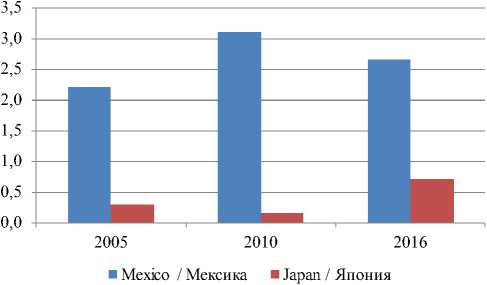
F i g. 1. Direct Foreign Investment Mexico-Japan14
P н с. 1. Прямые иностранные инвестиции (Мексика и Япония)
The great geographic distance and the so different cultures between both countries become an obstacle for Mexican exports. Figure 1 determines that the investment of manufacturing companies in Mexico has been increasing, putting into practice the interests agreed under the AAEMJ, the meaning of the great comparative difference of investment between both countries, is that Japan is a country with a stable, development and constant economic growth, while Mexico maintains problems in the Mexican economy. T. Okabe (2004) mentions that FDI in Japan has experienced a positive increase since the 1970s. But it seems that there are difficulties for mutual understanding because of the difference in culture and customs [10, p. 118].
The increase in direct foreign investment in Mexico results in the increase of imports of electronics, technological products to project and execute the activities of Japanese manufacturing companies in Mexico. Emphasis has been placed on the establishment of clear and reliable rules for the certainty of the origin of goods, as well as clear guidelines to verify compliance with the provisions on origin.
In terms of bilateral cooperation, provisions have been defined that allows promoting the strengthening of economic relations between Mexico and Japan. In this way, it is intended to promote activities in specific areas of mutual interest such as: Support industry; small and medium businesses; promotion of trade and investment; science and technology, education and job training; tourism; farming; environment; intellectual property; and improvement of the business environment.
Customs procedures and rules of origin in the AAEMJ:
-
1) Sanitary and phytosanitary regulations. It preserves the right of each State to adopt sanitary measures to protect human, animal or plant life or health against risks of diseases, pests, additives or contaminants;
-
2) Temporary entry of business people. Entry and temporary migration of persons for business purposes. Migration authorities should not take more than 30 calendar days to issue the document;
-
3) Safeguards. They have a strictly tariff character and their maximum duration is four years and does not apply to the limited quotas the degree of openness in force in the national legislations;
-
4) Services. The following services stand out: transport, professionals, telecommunications, distribution and tourism, etc. The principles stand out: National treatment, most favored nation and is consolidated;
-
5) Investment. They emphasize the principles of national treatment most favored nation, prohibition of the establishment of minimum quantities of production, freedom of transfer prices and mechanisms for solving investor-state disputes;
-
6) Government purchases. Guarantees that the access of goods and services to Mexican and Japanese suppliers in the matter of government purchases are made in national treatment. Mexico offers national treatment to the USA;
-
7) Economic competition. Arrangements were made regarding nondiscrimination; transparency in the application of laws; treatment of confidential information;
-
8) Standards, technical rules and evaluation procedures. Provisions that induce technical cooperation between the governments of both countries are contemplated; determination of points of agreement and the creation of a subcommittee that reviews the implementation and resolution of disputes in the agreement;
-
9) Bilateral cooperation. In the area of small and medium-sized enterprises, the intention is to intensify the cooperation links in science and technology, education and job training, the main objective is to take advantage of Japan’s experience to help increase the competitiveness of Mexican companies;
-
10) Tourism. The tourist flows between both countries are tightened, take advantage of natural resources and cultural diversity and promote training; through cooperation in the tourism sector;
-
11) Intellectual property. Agreed to the geographical indication for tequila and mezcal. Likewise, cooperation actions were defined: exchange of information on activities to create public awareness, function of protection systems, political measures to apply intellectual property rights;
-
12) Environment. Sustainable development is promoted through activities such as the exchange of technology related to the improvement and preservation of the environment and the construction of human and institutional capacities, among others15.
The development of cooperation links in science and technology, education, and job training, increases the quality of our workforce and, therefore, increases productivity and competitiveness for the benefit of Mexican companies, promoting at the same time investment opportunities and the increase of bilateral trade.
The close cooperation in the tourism sector under the AAEMJ, achieves the increase of tourist flows between Mexico and the Japanese country; making use of natural resources and cultural diversity. This helps strengthen the Mexican tourism sector as a source of income and job creation for the country of Mexico.
Figure 2 clearly shows the level of infrastructure that corresponds to each country, it is observed that Mexico is below Japan, which means that Japan has greater ease and quality when carrying out merchandise trade. It can be considered that Mexico remains at a medium level until 2016, the increases in investment in infrastructure by the Mexican government as of 2007 have not been large changes, we see a growth of 3 in 2014, however, for 2016 it reduced to 2.7.
Concluding that the lack of infrastructure is an obstacle for Mexican exports to grow which leads to the country’s trade deficit. On the contrary, industries in Japan are located with the development of applied technology and production of goods with excellent quality indexes.
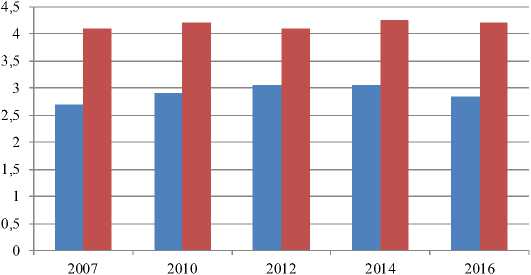
■ Mexico / Мексика ■ Japan / Япония
F i g. 2. Logistics performance index: quality of infrastructure related to trade and transport (1 - low to 5 - high)16
P и c. 2. Индекс эффективности логистики: качество инфраструктуры, связанной с торговлей и транспортом (от 1 - низкая до 5 - высокая)
The following is a statistical analysis of the 2005-2016 period in the context of Mexico Japan based on bilateral trade.
Table 9 shows that exports have been increasing since the entry into force of the AAEMJ, at the same time as imports made by the Mexican country, where imports (purchases abroad) are greater than exports (sales to external), consequently causing a deficit in the Mexican trade balance that has been increasing.
T a b l e 9. Number of exports and imports 17
Т а б л и ц а 9. Число экспортных и импортных поставок
Trade balance of Mexico with Japan. Values in thousands of dollars / Торговый баланс Мексики с Японией (в тысячах долларов)
|
Year / Год |
Exports / Экспорт |
Imports / Импорт |
Total trade / Общий объем торговли |
Mexican trade balance / Торговый баланс Мексики |
|
2005 |
1,470,012 |
13,077,780 |
14,547,792 |
-11,607,768 |
|
2006 |
1,594,038 |
15,295,157 |
16,889,195 |
-13,701,119 |
|
2007 |
1,912,637 |
16,342,979 |
18,255,616 |
-14,430,342 |
|
2008 |
2,046,035 |
16,282,450 |
18,328,485 |
-14,236,415 |
|
2009 |
1,600,591 |
11,397,105 |
12,997,696 |
-9,796,514 |
|
2010 |
1,925,554 |
15,014,685 |
16,940,239 |
-13,089,131 |
|
2011 |
2,252,287 |
16,493,493 |
18,745,780 |
-14,241,206 |
|
2012 |
2,610,742 |
17,655,200 |
20,265,942 |
-15,044,458 |
|
2013 |
2,244,050 |
17,076,109 |
19,320,159 |
-14,832,059 |
|
2014 |
2,608,476 |
17,544,572 |
20,153,048 |
-14,936,096 |
|
2015 |
3,017,501 |
17,368,168 |
20,385,669 |
-14,350,667 |
|
2016 |
3,770,974 |
17,751,100 |
21,522,074 |
-13,980,126 |
The Mexican economy is not capable of self-satisfaction and the balance with respect to what it produces is lower and this affects the economic activity of the country. The solution to this problem is to encourage Mexican exports through economic support, orientation programs to the customs procedure, investment in the infrastructure of trade and transport; also get the growth of trade in Mexico. Figure 4, indicates the transition of inflation during the period 2005–2015 of the countries Mexico and Japan. On the part of the Mexican country, it maintains an inflation above 6 %, considering a high level, it is increasing until 2015; otherwise, Japan establishes inflation below Mexico, around 2 %. The inflation maintained by Japan is considerable for the development, balance and economic growth of the Japanese. Mexico’s high inflation is detrimental to the country’s economy, causing the devaluation of the currency, decreasing the wages of workers, decreasing investments in the productive sector, rising interest rates and growing unemployment, affecting the level of life of Mexicans (fig. 3).
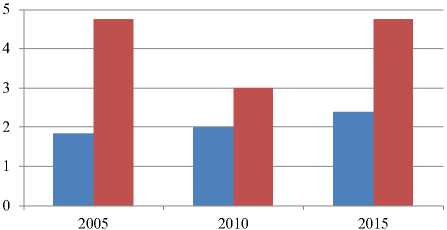
-
■ Japan / Япония ■ Mexico / Мексика
F i g. 3. Inflation México-Japan (2005–2016)
Р и с. 3. Инфляция в Мексике и Японии (2005–2016 гг.)
Figure 5 shows the high growth of GDP per capita in Japan compared to Mexico. It shows that Japan’s productivity and economic development is far superior to the economic and social conditions that exist in Mexico. Cause of this is the lack of employment and low growth in the Mexican economy, harming social welfare. In balance with Japan, this determines a high standard of living for the Japanese.
50 000
45 000
40 000
35 000
30 000
25 000
20 000
15 000
10 000
5 000
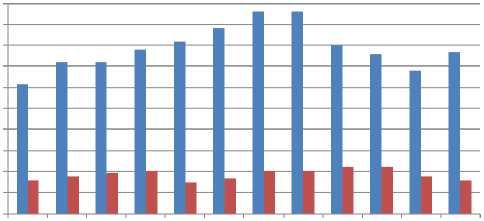
2005 2006 2007 2008 2009 2010 2011 2012 2013 2014 2015 2016
-
■ Japan / Япония ■ Mexico / Мексика
F i g. 4. GDP per capita Mexico Japan, 2005–2016
Р и с. 4. ВВП на душу населения в Мексике и Японии (2005–2016 гг.)
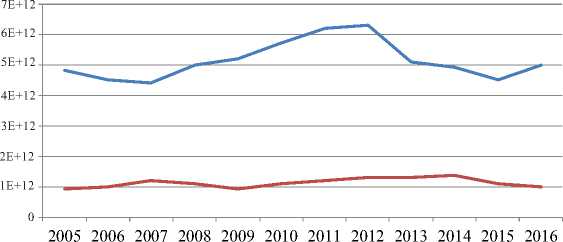
^™ Japan / Япония ^-Mexico / Мексика
F i g. 5. Mexico-Japan Gross Domestic Product, period 2005-201620
P и c. 5. Валовой внутренний продукт Мексики и Японии в 2005-2016 гг.
Figure 5 shows the Gross Domestic Product of Japan and Mexico during the period 2005-2016. Revealing the great difference in the level of productivity of each country. Japan maintains a high GDP, which means an increase in economic activity, unemployment tends to decrease and per capita income increases. In the opposite case, Mexico in comparison has a very low GDP, the production of goods and services has not been sufficient, impacting the country’s economic weakness.
Limitations of the research method. For the object of study of this investigation it was occupied that the aspects that make up the whole context were investigated, so that the documentary method was restrictive when investigating and collecting data to answer the study. The proposed variables did not result in positive or proportional effects in the Mexican trade balance.
Regarding the criterion of statistical analysis, it was easy to detect statistical data on the effects of the variables, and present them graphically to cany out the direct analysis and determine the result, which consequently makes it difficult to use the longitudinal criterion, through periods the study sample, which makes the study deeper and requires more time
Discussion and Conclusions. The hypothesis raised in this research assumes that the Mexico-Japan Economic Association agreement does not have a positive influence on the commercial balance. Given that
currently under the AAEMJ the Mexican economy has a deficit of 12 million dollars. It is verified with the hypothesis of the investigation that there are some advantages of the Economic Association Agreement Mexico Japan for the manufacturing exports of Mexican companies located in Jalisco confirming the same results of B. R. Gonzalez Galvez21. A relation between the objective of the hypotheses stated above of the empirical investigations is determined, and it is agreed that the AAEMJ as a result has not had positive effects in the commercial Balance, causing the trade deficit due to the imports made by the EDI Japan established in the country of Mexico or a possible trade diversion raised in the research Economic Association Mexico Japan: creation analysis and trade diversion 1999-2009.
The agreement with Japan has represented a link in the negotiation with Asia. It has also managed to consolidate an agreement with the second world economy, the twelve-year results that the AAEMJ entered into force do not show reciprocal benefits.
It is concluded that the Mexican Government’s strategy is to attract Japanese investments that promote the economic and technological development of the country. The following recommendations are based and are impulsive factors to increase Mexican exports to Japan. In the field of trade, there is potential to increase the participation and presence of Mexican products in the Japanese market. It is necessary that the Government and the Mexican private sector diversify Mexican exports to Japan; to achieve an export use of agricultural products, it is required to increase incentives to exporting companies; In addition to improving inspections at customs and improving the infrastructure of roads, airports, etc.
The research on Mexico-Japan relations is really scarce due to the fact that the most attention of studies has been for Mexico-US relations. Therefore, this research focuses on these relationships. Since the entry into force of the EPA to date, foreign trade between Mexico and Japan has been growing favorably. However, it requires a reconsideration on the advantages that the AAEMJ can offer as one of the alternatives for the economic development of both countries.
The investigation to the Mexico-Japan Economic Integration: its effects on the Mexican commercial balance, period 2005-2017, takes a focus of economic study and on the commercial relations that occur between countries. The future lines of research for this study are as fol-
^^ Том 26, № 2, 2018 РЕГИОНОЛОГИЯ lows: JEL: F01 - Global perspective, JEL: F14 - Studies on trade by country and industry, JEL: F15 Economic integration.
During the period of time used to carry out this investigation, certain limitations were presented; consequently, it was not possible to carry out an in-depth analysis of the object of study of the investigation. These limitations are classified into time, money, access to information and reliability. The time, is an important indicator for the application of a deep study in some investigation, therefore, the time destined to this investigation was very short, for the same reason they were conducted problems that made the search difficult.
The expected impact of the Mexico-Japan EPA to increase trade between both nations does not seem clear 12 years after its entry into force. The participation of the commercial exchange maintains rates with ups and downs and a decreasing tendency. Mexico maintains a deficit trade balance against Japan at an average close to 13,000 million dollars. It should be noted that domestic exporters are not taking full advantage of the agreement; the actions achieved within the framework of the agreement on SMEs do not respond to the needs of this sector in Mexico.
The level of productivity of each country (GDP) impacts the growth and economic and social development of the country. Therefore, it is very important to be a self-sufficient country in the production of goods and services to establish stable economic indicators that do not affect the country’s trade balance. Mexico for the benefit of the AAEMJ has increased its exports of food of agricultural and fishing origin. However, the total exported to Japan represents a deficit in the Mexican trade balance. On the other hand, Japan exports to Mexican territory have been products of information technology and transport equipment, including automobiles.
Mexico has attracted Japanese foreign investment, which is the cause of the trade deficit because the manufacturing companies installed in Mexico import intermediate inputs. The lack of development in infrastructure leads to operational deficiencies that become an export obstacle for Mexican SMEs. To increase the participation and presence of Mexican products in the Japanese market, it is necessary that the government and the Mexican private sector work in the development of exportable offer from Mexico to Japan oriented to: diversify Mexican exports to Japan; maximize the tariff preferences provided by the AAEMJ and achieve greater export exploitation.
Список литературы Integration of Mexico-Japan in the economic association agreement: its effects on the Mexican trade balance, 2005-2017 period
- Tokoro Ya. Mexico y Japon: una perspectiva del Acuerdo de Asociacion Economica. Economia Unam. 2006; 3(7):47-68. Available at: http://www.redalyc. org/articulo.oa?id=363542888003 (accessed 20.02.2017).
- Okabe T., Carrillo R.S. Relaciones Mexico Japon en el contexto del Acuerdo de Asociacion Economica (primera Ed). Mexico: Juan Pablos Editor; 2014. Available at: https://www.elsotano.com/libro-relaciones-mexico-japon-en-el-contexto-del-acuerdo-de-asociacion-economica-10443089 (accessed 20.02.2017).
- Delgado G.M. Mexico estructuras politica, economica y social (tercera Ed). Naucalpan de Juarez, Edo. Mexico: Pearson Educacion de Mexico; 2009. Available at: https://ru.scribd.com/document/347775647/Mexico-3ra-Ed-Gloria-M-Delgado-de-Cantu (accessed 20.02.2017).
- Garcia G. Mexico Japon: comercio bilateral en el marco del Acuerdo de Asociacion Economica. Revistas Bancomext. 2010; 60(2):116-125. Available at: http://revistas.bancomext.gob.mx/rce/magazines/135/2/116_GARCIA_mex_japon. pdf (accessed 20.02.2017).
- Paschoal R.J. Introduccion a la economia (decimoquinta Ed). Mexico: D.F., editores, impresores Fernandez S.A. de C.V.; 2000. Available at: https://www. casadellibro.com/libro-introduccion-a-la-economia-18-ed/9789706136824/812240 (accessed 20.02.2017).
- Robert C.F., Taylor M.A. Comercio Internacional (primera Ed). Barcelona: Editorial Reverte; 2011. Available at: http://www.reverte.com/catalogo/ficha/ comercio_internacional-8781 (accessed 20.02.2017).
- Vazquez M.S., Madrigal R.J. Comercio internacional. (Primera Ed.). Mexico: Grupo Editorial Patria, S.A. de C.V.; 2007. Available at: http://editorialpatria. com.mx/detalle-de-libros.php?ID=455 (accessed 20.02.2017).
- Gracia H.M. La Nueva Teoria del Comercio Internacional en la pos-modernizacion de la economia global. Temas de Ciencia y Tecnologia. 2009; 13(37):19-22. Available at: www.utm.mx/edi_anteriores/temas037/E3-.pdf (accessed 20.02.2017).
- Gutierrez Casas L. E. Teorias del crecimiento regional y el desarrollo divergente. Propuesta de un marco de referencia. Revista de Ciencias Sociales y Humanidades. 2006; 15(30):185-227. Available at: http://www.redalyc.org/ articulo.oa?id=85903008 (accessed 20.02.2017).
- Okabe T. Sinopsis del Acuerdo de Asociacion economica Mexico y Japon. Mexico y la Cuenca del Pacifico. 2004; 7(23): 103-123. Available at: http:// www.mexicoylacuencadelpacifico.cucsh.udg.mx/index.php/mc/article/view/239 (accessed 20.02.2017).

